British Tiller girls
Popular between 1901 and 1920, the distinguishing characteristics of
the synchronized Pony Ballet dancers was
their youth (no older than 19), petite size (no more
than 5' tall and less than 130 lbs) and frequent costume changes. Trained in England at the
famed Tiller School operated by John Van Tiller,▼1
the dancers that would become the Pony Ballet
first performed in James Lederer's
The Belle of New York at the Shaftesbury Avenue theater in London
in 1896.▼2 He hired them for a
George Lederer (1862–1938) production in America, The Man
in the Moon.
To the moon and back
A group of sixteen dancers came to the U.S. in 1899 for Moon, then
returned to England. While still in New York they were
spotted by a Chicago theater manager,
Will J. Davis, who four years later would play an
important role in their lives. In 1900 they
appeared in E.E. Rice's Little Red Riding Hood.
See below.
In 1901 half the group returned
to America to appear in Casino Girl, another
G.W. Lederer production.
See photo below right of the group that appeared in
Casino, each of them age sixteen to nineteen.
Four in the group were said to be from London and four from
Newcastle-upon-Tyne. Four were blonde and four
brunette. It was during Casino that George Lederer gave them
the name Pony Ballet, originally billed as the Pony
Ballet Octet.
Taking a bunk
When Casino closed, the girls chafed at sitting idle for a period of weeks.
Though Lederer had agree to pay them during the off
period, the amount was not sufficient for them to
continue sending money home to their families. So, to put it in their words, they "took a bunk"
— British slang similar to the American
"taking a powder." Without telling Lederer,
they found a vaudeville booking in St. Louis, had costumes made
and slipped off when he wasn't looking.
Factoring in their decision may have been that
compensation for vaudeville performers was catching
up and sometimes exceeded that of dramatic stars.
Two months before a California newspaper article
cited as an example the $37,000 earned by
Jessie Bartlett Davis as comparable with her
earnings when a dramatic star with the Bostonians.
On their own
The girls elected
Beatrice Liddell as their leader and assigned other
roles to members (see right). In 1902 while performing in
Milwaukee, one of the girls,
Eugenie Makepiece, died of typhoid fever.
Carrie Poltz was also stricken but survived.
Mr. Bluebeard
When rehearsals
began for Mr. Bluebeard in NYC January, 1903
Eugenie's position was filled by Dorothy Marlowe
(presumably a relative of Eva's though I was unable
to verify that).
Their costumes for
Bluebeard were designed by F. Richard Anderson and made by
the Klaw & Erlanger Costume Company; wigs were
produced by Clarkson of London and Hepner of New York.
Five in the Pony Ballet — the
Hawman sisters, Bee and the Marlow sisters -
traveled home to England for a visit between the
Broadway season of Mr. Bluebeard and the start of
the road company tour on Sep 1, 1903.
The Pony Ballet appeared in a
pre-opening promotional performance at Powers Theater
in Chicago on November 17, 1903.
At the Iroquois the afternoon
of the fire, the Ponies had just completed a
performance with
Bonnie Magin and
Harry Gilfoil in The Beer
That Made Milwaukee Famous. When the fire
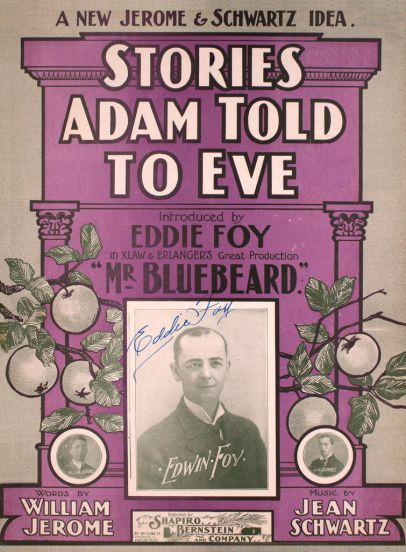 started they were in their dressing rooms preparing
for their next appearance on stage, the Old Woman
Who Lived in a Shoe skit followed by Mother
Eve (aka "Stories Adam Told to Eve")
skit in Act II, Scene 3, both with
Eddie Foy. They may have been among
the performers brought down in the elevator to the
stage floor by operator
Robert Smith or could have used the spiral
stair.
started they were in their dressing rooms preparing
for their next appearance on stage, the Old Woman
Who Lived in a Shoe skit followed by Mother
Eve (aka "Stories Adam Told to Eve")
skit in Act II, Scene 3, both with
Eddie Foy. They may have been among
the performers brought down in the elevator to the
stage floor by operator
Robert Smith or could have used the spiral
stair.
Sisters Dorothy and Eva Marlowe were injured at
the Iroquois but recovered sufficiently to perform a week later. The company traveled
with the Mr. Bluebeard cast back to
New York City after the Iroquois fire, arriving on
January 5, 1904. They had a booking in NYC
twelve days later, at the New Star Theater in Brooklyn and a week later were
again headlining shows.
May 15, 1904 The Inter Ocean newspaper
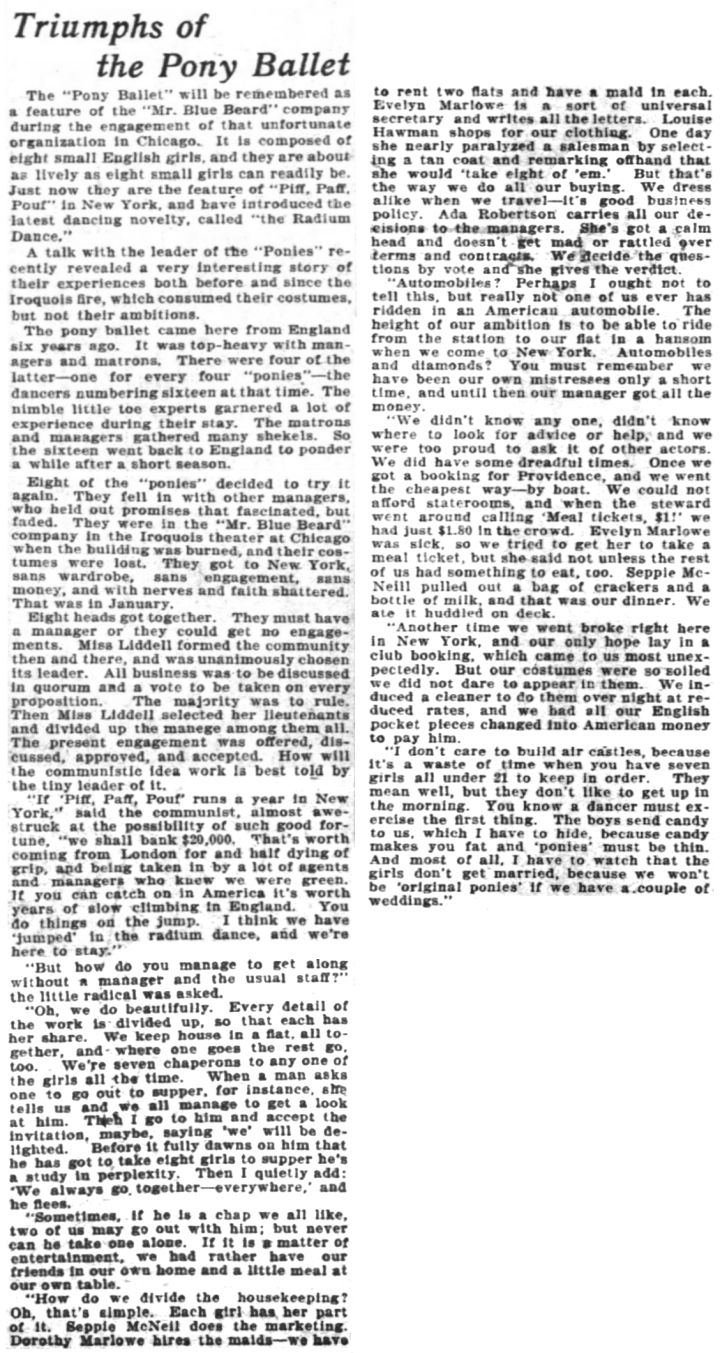
Enlarge
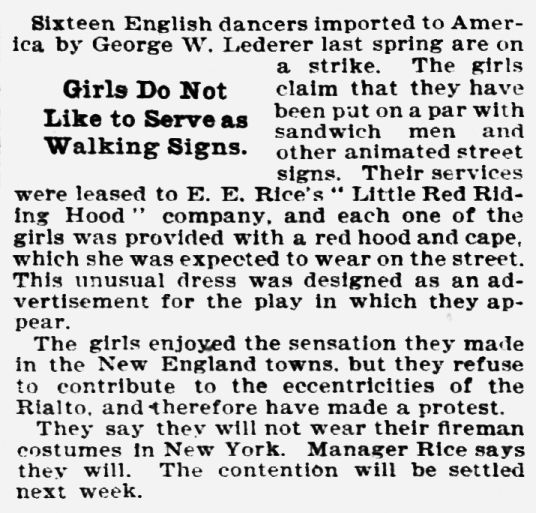
Wearing identical red hooded capes on the
street was resented in1900 when it was a
requirement but by 1902, wiser about
promotion, the Pony Ballet girls adopted the
practice as a shrewd marketing scheme.
|
 |
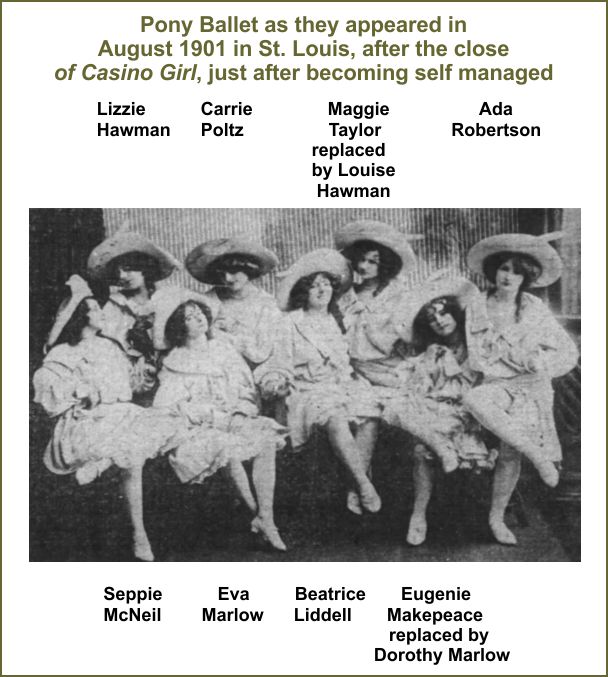
|
Pony Ballet dancers of Mr.
Bluebeard.
What I've been able to learn of them so far:
|
|
Elizabeth "Lizzie"
Lizette Hawman (Hauman/Harman) (1882–)
Nicknamed Homan, said to be the oldest.
She escaped without injury from the Iroquois
Theater.
In 1906 Lizzie and Louise's mother, three younger siblings and an
adopted sister immigrated to America from England and in 1910 were
living in New York. Their parents were the late Hugh Hawman
and Margaret Hawman. Their younger sister and the adopted
sister also worked as dancers. One, named after their mother
Margaret, eventually joined the Pony Ballet.
In 1907 when a stage worker died of a stroke while working, Lizzie
came to his aid during his final moments and extended comfort to his
family. The stage crew honored her kindness with a gift makeup
box and plaque.
|
|
Louise "Lonie"
Hawman (Hauman/Harman) (1888–) purchased clothing for the group. She was
Lizzie's sister. She escaped without injury
from the Iroquois Theater. See information
about Louise and her sister Lizzie's other family members above.
In 1912 Louise was performing with Ada, Eva and Sissie in Ned
Wayburn's company in Connecticut.
|
|
Beatrice Liddell (c1884–1972?), nicknamed Bee,leader of
the group. Said to be the youngest but that may have been a joke. She escaped
without injury from the Iroquois Theater. In
Mar 1899 while appearing in Man in the Moon
in New York, Bee and another cast member had filed
to become American citizens.
|
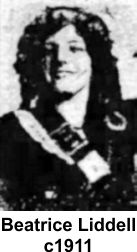
|
|
In 1901 she won a dance endurance contest in London. In Dec
1911 Beatrice performed in Eddie Foy's three-act farce, Over the River, in the role of Phebe, singing
Raggety Man among others. I suspect Beatrice was
Margaret Beatrice Liddell who married Frederick
Adams Russell in 1914. If so she was the
daughter of Joseph and Margaret Hobson Liddell with
a sister named Isabelle and lived to ninety years
of age, passing in Apr, 1972. They had one child, a
son named William A. Russell and Bee spent most of her
married years in the New Ipswich, NH area.
|
|
Dorothy Marlowe (1885– )
suffered slight burns at the
Iroquois. One of her chores in the group was to hire maids.
It was reported that the group typically rented two apartments and hired a maid for each
apartment. Another Dorothy Marlowe sang light opera around
1911, thought to be a different woman. In 1912
an entertainer named Dorothy Marlowe married a man named Bixler
but I think it was the other Dorothy.
|
|
Evelyn "Eva" Marlowe (1879–1970)
handled the group's
secretarial chores. She later
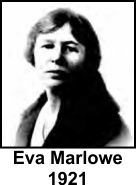 married Bertrum
Levyn / Levin (1874–1952) in 1910. He worked then as a realtor and later
in public relations, publishing and theater
management An Eva Marlowe was performing in 1924 and 1930, in
musical comedies on Broadway such as "the Girl He
Left Behind" produced by Tommy Hanlon. Was it Eva
the former Pony? Don't know. Eva and Bertrum
lived in NYC until his death, then Eva moved to
Danville, PA to share an apartment with former
Pony mate, Ada Robertson Bryant, who had also lost her spouse. Eva
relocated to Troy, NY by the time of her death.
married Bertrum
Levyn / Levin (1874–1952) in 1910. He worked then as a realtor and later
in public relations, publishing and theater
management An Eva Marlowe was performing in 1924 and 1930, in
musical comedies on Broadway such as "the Girl He
Left Behind" produced by Tommy Hanlon. Was it Eva
the former Pony? Don't know. Eva and Bertrum
lived in NYC until his death, then Eva moved to
Danville, PA to share an apartment with former
Pony mate, Ada Robertson Bryant, who had also lost her spouse. Eva
relocated to Troy, NY by the time of her death.
|
|
Seppie
(Septima Septine Septins Septina Seppie) "Sissie" McNeil (1885–)
handled marketing for the group. She escaped without injury from the
Iroquois Theater. In 1910 her niece, Mollie Dawson, lived
with Sissie, Dorothy Marlowe, and Beatrice Liddell
in Manhattan. Sissie continued performing in
and leading a vaudeville pony-style dance group of
six women called the Dancing Daisies until at least 1914, the last
newspaper mention of her in November of that year.
|
|
Carolyn Hanna Louise "Carrie" Poltz (1884–1963).▼4
She escaped without injury from the
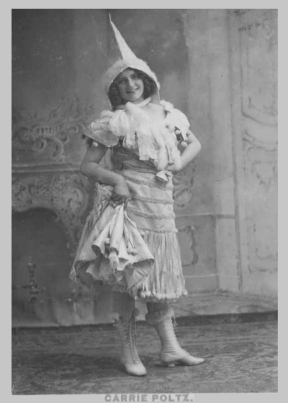 Iroquois Theater. In 1910 she and her younger sister, Florence Poltz, also an actress,
lived with Eva Marlowe Levyn and her husband in Manhattan. Carrie
and Louise were the daughters of Heinrich Poltz and Sarah Graham Poltz.
Iroquois Theater. In 1910 she and her younger sister, Florence Poltz, also an actress,
lived with Eva Marlowe Levyn and her husband in Manhattan. Carrie
and Louise were the daughters of Heinrich Poltz and Sarah Graham Poltz.
In 1925 Carrie was part of the Charlotte's Revue road company, based in London but working
in the U.S. She was in charge of selecting and
training chorus girls. She used her mother's maiden name then,
Graham. In 1932 she married John A. "Jack" Chapman of England.
|
|
Ada Robertson, a native of Scotland,
was the group spokesman when
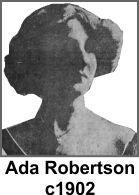 communicating with producers and theater managers.
She escaped without injury from the Iroquois
Theater. She later married a man named Bryant and remained in the U.S., living in Danville, PA, as a
widow, childless, sharing an apartment with her former Pony member Eva
Marlowe Levyn. In 1954 she recalled her years in early film after
her Pony years.
communicating with producers and theater managers.
She escaped without injury from the Iroquois
Theater. She later married a man named Bryant and remained in the U.S., living in Danville, PA, as a
widow, childless, sharing an apartment with her former Pony member Eva
Marlowe Levyn. In 1954 she recalled her years in early film after
her Pony years.
|
|
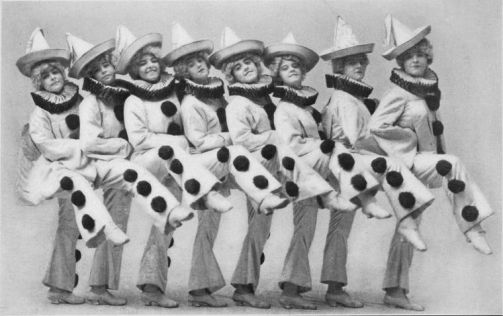
Picture above most probably shows the
costumes worn during the Pony Ballet's
1904 radium dance in the last act of Piff-Paff-Pouf.
They were described in newspapers as of a
Pierrot type with attached ruffles and
were pictured on sheet music (below)
published in conjunction with the
production. The light-colored portions
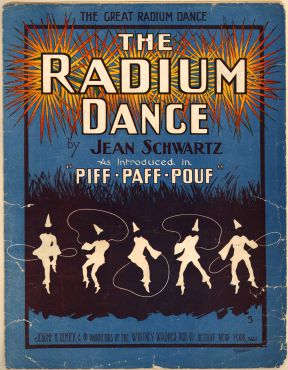 were painted. Skipping rope was a key
component of the radium dance.
Listen to the
Jean Schwartz tune Radium Dance that
accompanied the performance. It
seems that the paint would have made the
fabric stiff and heavy to the point of
chafing the skin but the radium dance
became one of the Pony Ballet's
longest-running skits, picked up in
productions subsequent to
Piff-Paff-Pouf.
were painted. Skipping rope was a key
component of the radium dance.
Listen to the
Jean Schwartz tune Radium Dance that
accompanied the performance. It
seems that the paint would have made the
fabric stiff and heavy to the point of
chafing the skin but the radium dance
became one of the Pony Ballet's
longest-running skits, picked up in
productions subsequent to
Piff-Paff-Pouf.
|
|
|
|
In the years after the fire
The group became so popular in 1904 that the term "pony ballet" became a common
place description for groups everywhere of young,
identically clad female dancers. For a time
the Pony Ballet referred to itself as the "English
Pony Ballet," later changing the name to the
"Original Pony Ballet" and "Original English Pony
Ballet." In 1905-7 they featured in "Piff Paff
Pouf," becoming best known for skipping rope, tap
dancing and their "radium dance" skit. Dressed
in
Pierrot costumes embellished with phosphorous
discs, they entered a dark stage and danced
with phosphorescent ropes. (The
Piff-Paff-Pouf music book.)
The summer of 1904 was spent
living in a cottage on Hemmels, Long island.
A newspaper interview with Eva and Ada
in their senior years shared their feelings that the
success of the Pony Ballet was due to their hard work and willingness to adapt and learn new things, such as
learning to play bagpipes for one show and
xylophones for another.
By 1905 only six
Ponies remained, Eva Marlowe and Carrie Poltz
having left the group.
When they performed with
the Lew Fields production Girl Behind the Counter
in Chicago in 1908 at the
Garrick Theater, former Iroquois Theater manager
Will J. Davis came back stage to greet the
girls. He recalled his first view of them when
they earned $10/week.▼3
|

|
Pony craze comes to an end
Later in 1908 Bee, Dorothy, Ada and Sissie went home to visit their families in England and
traveled home on the Mauretania. Dorothy stayed for eight months for
eight months and returned with an Bee's sister, Isobelle Liddell. There were fewer newspaper ads mentioning the group
in 1910 and in the U.S. Census that year they reported they'd been out of
work for 7 weeks that year.&
Bee Liddell, Dorthy Marlowe, Ada
Robertson, Elizabeth Hawman, Louise Hawman and Seppie continued to perform
as the Pony Ballet until 1911. At least one newspaper that year the
group as overplayed.
In Feb 1911 the remaining
five were performing in St. Louis, but not as a group and not as the Pony
Ballet. Ada, Beatrice, Lizzie and Dorothy were performing in "The Old Town"
at the Olympic Theater while Eva appeared in Tillie's Nightmare at the
Shubert Theater with Maggie Taylor, one of the Pony members from 1901.
Advertisements promoting the "English
Pony Ballet" and "Original Pony Ballet continued to appear well into
the 1920s, long after the original Pony Ballet had left the stage — with
various males taking credit for the Pony Ballet phenomenon created by eight
young women from England.
|
|
|
Discrepancies and addendum
Radium Ballet
1. In 1911
Beatrice Liddell described the
Tiller School as having turned out hundreds of
dancers, most of whom performed in ballet in
European theaters. There were two Tiller School
sites, one in Limehouse, Manchester, the other in
Covent Garden, London. Young students from five to
ten years old started at the Manchester school as
borders with a matron for every four girls. Their
training included academics as well as dance. Girls
with potential received further training and entered
a program Beatrice likened to an apprentice program
for a trade.
2. The term "pony
ballet" appears to have been a permutation of an
older term, "jockey ballet," going back to at least
the mid 1800s. Both terms were used to describe a group
of young female dancers. Other references put
their debut at the Drury Lane Theater. Later
reports said four came from northern
Northumberland and Yorkshire, one from Liverpool and
one from London.
3. This would have been
in 1901 when Davis was in New York to see a much-heralded race between trotters
Creseus and The Abbot with Davis Raitters at his Willowdale farm in Crown Point,
Indiana. Also at the race, possibly in company
with Davis, was a E. E. Rice,
producer of Little Red Riding Hood and a
personal friend of Davis's.
4. In an AP newspaper story
that appeared in the Jan 5, 1904 issue of The Boston Globe on 1,5/1904
Carolyn Louise Poltz name was reported as Clara Palez.
|
